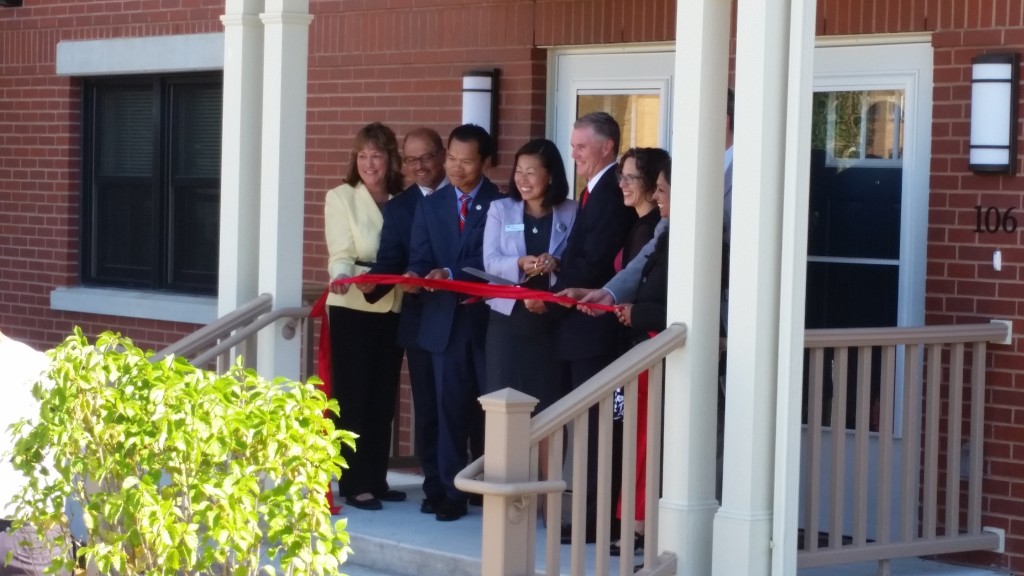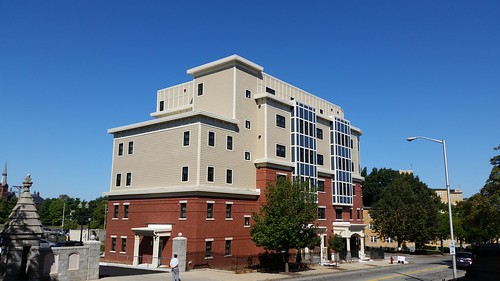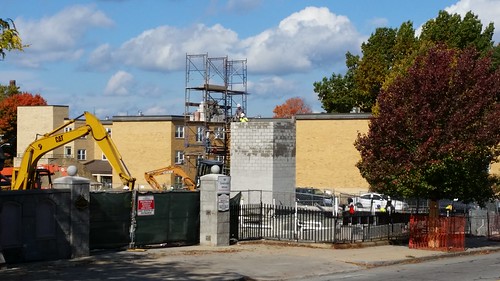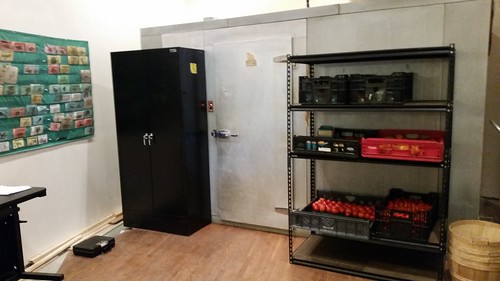Lowell Week in Review: September 20, 2015


Coalition for a Better Acre Gorham Street Apartments
CBA Gorham Street Apartments
Congratulations to Coalition for a Better Acre which held a ribbon cutting ceremony for its Gorham Street Apartments on Thursday. I was sure to attend because I’ve felt connected to this project from the day it started, mostly because it is right across the street from my office. Each morning when I arrived at work the building was bathed in sunlight (on sunny days, at least), just asking to be photographed. My frequent cell phone pictures posted on social media documented the construction of the building. CBA speakers at the ribbon cutting kindly gave me a shout-out for my photographic efforts.
The apartment building contains 24 high quality, energy efficient units with multiple bedrooms. CBA will pay the city of Lowell approximately $50,000 per year in property taxes on this building which was designed to blend in to the surroundings. The affordable rent being charged will allow those who live in the apartments to spend more money elsewhere in the city. As one of the speakers said, “Housing stability equals city stability.” So congratulations to the Coalition for a Better Acre for a job well done.

Jan 2015

Oct 2014
Mill City Grows
On Monday, I stopped at the official opening of the Mill City Grows offices on Western Avenue. The facility contains offices, conference rooms, storage space, and a walk-in refrigerator. Mill City Grows does great work in promoting urban agriculture. It also is a link back to our past. In my research of Lowell history, it occurred to me that most of the immigrants who came to this city (including my ancestors from Ireland) came from rural backgrounds. While they were drawn to Lowell by work in the textile mills, as soon as they could secure a small plot of ground here in the city, be it as land owners or tenants, they began growing vegetables and fruits both to supplement the family food supply but also as a link to the life they once lived in their country of origin. That was true of those who arrived in the 1840s and it’s true of those arriving today. So besides being good for our collective health and for the environment, urban agriculture is another example of how we are all connected.


On a related note, be sure to visit the 4th annual Mill City Grows Harvest Festival next Saturday, September 26, from 1 to 5 pm on the North Common.
City Council
The Lowell City Council remains on its every-other-week summer schedule so there was no meeting this past Tuesday. The agenda for this coming Tuesday contains ten motions. Here they are:
- Mercier – Request City Manager meet with DPD to discuss ways to mediate the issue with residents who abut the Concord River Walkway
- Mercier – Request City Manager find ways and means to relocate the dog park if the present dog site is dissolved
- Mercier – Request City Manager arrange a meeting with the UML Human Relations Director and person in charge of student services, UML Chief of Police and Supt of Lowell Police to discuss issues affecting the Pawtucketville neighborhood
- Mercier – Request City Manager invite all artists whose paintings adorn City Council Chambers to an upcoming City Council meeting.
- Milinazzo/Rourke – Request City Manager contact Mass DOT to discuss adjusting the timing of the signals on the Rourke Bridge to accommodate both morning and afternoon traffic volumes
- Rourke – Request City Manager have Traffic Engineer review general traffic patterns in the City and explore options to lessen congestion
- Leahy – Request City Manager have proper department explore possibility of planting two trees at the corner of Merrimack and Cabot Streets
- Leahy – Request City Manager have proper department work with Mass DOT to alleviate traffic congestion while work is being done on Bridge Street/VFW Highway intersection
- Belanger – Request City Manager update council regarding Pawtucketville voting precincts
- Samaras – Request City manager work with Parks Department to prepare Kerouac Park for upcoming Columbus Day weekend Kerouac Festival.
There are several responses to prior motions worth mentioning.
To a Council Samaras motion regarding the monitoring of the South Common, a Lowell Police Department memo states:
. . . The South Common is one of the larger city parks and requires extra attention. Recently the South Common has become a location where individuals are erecting campsites overnight. This is a violation of the city ordinance that addresses the parks hours of operation. Officers on the evening shift have begun inspecting the park to ensure that the park is vacant during those hours in compliance with the ordinance. . . Additional problems that are encountered at the South Common are alcohol and drug use which is monitored daily.
In response to a motion requesting a list of events that have occurred at the Lowell Memorial Auditorium and at the UMass Lowell Tsongas Center, Special Events Coordinator Henri Marchand wrote a memo that included a list of all of the activities at these two venues from the start of this September up until the end of this year.
In response to a motion asking that a hotel be specifically included in the RFQ for the Hamilton Canal District, DPD wrote a memo that included this:
. . . [A 2012 study by the Pyramid Group] concluded that there was not sufficient market demand to support the construction costs of additional hotel rooms in downtown Lowell. The report cited the significant number of hotel rooms on the City’s edges . . . that could meet the hotel demand in the Lowell-area market. However, as market demands change and event programming increases at the UMass Lowell Tsongas Center, the City continues to pursue opportunities to partner with developers to find a private market solution to create a downtown Lowell hotel.
The RFQ for the Hamilton Canal District was amended to include this sentence: “The City invites proposals seeking to create alternative projects such as a hotel . . .”
Downtown Tourism
Picking up on that previous item regarding a hotel in the Hamilton Canal District, I’ve long believed that much of the efforts of the city and related entities to increase tourism are misdirected by not focusing on those who actually live in the city or in the neighboring communities. For several decades we’ve sought the holy grail of hordes of out-of-town visitors arriving in Lowell for long weekends of profligate spending. Even though it has not worked, we pursue the same strategy. It reminds me of that old saying: “Insanity is doing the same thing over and over again and expecting different results.”
I’m certainly not saying that tourism should be abandoned. What I am saying is that if you plop a family of tourists in downtown Lowell on any weekend morning or afternoon, these visitors to the city will feel isolated, alone, and vulnerable. That’s because there are few people populating the sidewalks of the city on weekends. For tourism to succeed, you need a critical mass of people to provide the tourists with that “safety in numbers’ feeling that the slickest advertising campaign will never overcome.
Where will all of these “extras,” to use a film-industry term, come from? There are 108,000 people who live in Lowell and at least another 100,000 who live in the contiguous suburbs. Why isn’t more being done to bring those who live in the city and its neighborhoods into downtown on a regular basis? Big festivals are great but they are resource and money intensive and don’t happen very often. Why don’t we ask people to just come downtown, walk around, and to do that often. There are plenty of interesting things to see and experience. Even if the locals don’t spend a cent (although they certainly will), having a critical mass of people occupying downtown will lend an air of vitality to the area that is now lacking. And it is that sense of vitality, that feeling that you’re not alone but part of a bigger movement that builds the type of positive, grassroots perception that an advertising campaign could never achieve by itself.
As for the idea of a hotel in downtown, I understand that conventions steer clear of Lowell because there is no hotel to accommodate their participants within walking distance of the Tsongas Center of the Auditorium, but how would such a hotel survive? Let’s say there were 20 conventions that came to the city per year, each for three nights. That would be 60 nights of occupancy in a hotel. Who would stay there the other 305 nights? That’s why the Lowell Hilton became the Lowell Sheraton and then the Lowell Doubletree and then the UMass Lowell Inn & Conference Center.
I’m not saying that a hotel would never work in downtown. I am saying that it won’t work until there is a substantial increase in the number of people who spend time on the streets and in the businesses of downtown Lowell.
Last week I tried to find a hotel room for someone who had to stay over in Lowell on Wednesday night. The Marriott Courtyard was full, all of the hotels on 133 near 495 were full, the Radisson and Best Western in Chelmsford was full . . . I finally found a room at a hotel in Andover. What I was told was that getting a room around Lowell on Tuesday or Wednesday night is pretty much impossible.
I like the idea of a hotel downtown, but perhaps not a monumental hotel . . .
I think that a hotel in Hamilton canal could be a potential draw for business travelers along the 495 corridor. Personally, I would much rather stay downtown than in the Courtyard Billerica or any of the Tewksbury or Westford hotels.
The corollary to this is why would far away visitors visit a place that local (read near by) people avoid?
On Saturday after the convention we took a few minutes to see the Augustus St. Gaudens statue ‘The Deacon Samuel Chapin’, more commonly known as ‘The Puritan’. This statue is in front of the Springfield Museum. What we found in our short one block walk was very few people walking or waiting about.
After seeing the statue we looked for a nice ‘tourist’ friendly place to have lunch before setting out on our way back to Lowell. To the east and north of the convention center we found nothing that meet our wishes. We saw a number of ‘gentleman’ clubs and a few seemingly nice places that did not open till evening. While Lowell has done better than Springfield in the Market-Middle-Merrimack street downtown, it is clear your message is dead on. Make the area interesting to the locals, and the out of state, out of country visitors will follow. Any visit to the MFA or North End in Boston will quickly show lots of locals along with out of state and out of country people, confirming your astute observation.
A Tale of Two Cities.
There are two types of development patterns: Drivable Suburban and Walkable Urban. For arguments sake I’ll say our Drivable Suburban neighborhoods are Upper Belvidere, West Pawtucketville, Upper Highlands, Upper Christian Hill etc. Our Walkable Urban neighborhoods are Lower Belvidere, Back Central, The Acre, Lower Centralville, parts of South Lowell and of course the Downtown.
The Walkable Urban Lowell neighborhoods were all built much prior to the car-centric era of the 1950’s on. After WWII people with choice(money) moved out of the dirty, dangerous, walkable urban neighborhoods to the new drivable suburban neighborhoods in outer Belvidere, Dracut, and Chelmsford. Retail, restaurants, and offices soon followed.
The people without choice(money) were left remaining in the walkable urban neighborhoods but there weren’t many good paying jobs to walk to anymore. A vicious cycle of poverty, neglect, and blight afflicted these neighborhoods. See High on Crack… St https://www.youtube.com/watch?v=oKIP6qlTalI
Fortunately enough people with choice decided to stay in the drivable suburban neighborhoods so Lowell never truly hit rock bottom. See Richard Donahue… http://www.washingtonpost.com/politics/richard-donahue-presidential-aide-who-became-nike-president-dies-at-88/2015/09/16/8db0753e-5c89-11e5-8e9e-dce8a2a2a679_story.html
The conventional wisdom of the last 60+ years has been to attract people with choice(money) to drive to downtown Lowell to eat, shop, and hopefully attract some good paying jobs. We widened streets to allow for more lanes and better traffic flow. We banned on-street parking in places where traffic flow is paramount. We instituted minimum parking requirements for new construction so there would be enough off-street parking at peak times of the day. We spent millions building parking garages. We zoned neighborhoods so that where we sleep and where we shop would be far enough away from each other that getting in the car became the rational way to move about the city.
This is the epitome of the term “Tragedy of the Commons”-a situation where individuals acting independently and rationally according to each’s self-interest behave contrary to the best interests of the whole group by depleting some common resource.-Wikipedia.
It’s completely rational that I drive from Upper Belvidere to DTL, circle the block to find an on-street spot, eat at Tre-Monte Pizzaria, and drive home. It’s also completely f’ing insane when you think about how close I live to DTL and how easy it would be to walk or bike instead. But it doesn’t feel safe to walk or bike to DTL with my family because the streets have been widened and lanes added for traffic flow. On-street parking is banned on much on Andover street south of Nesmith St which could provide a buffer for pedestrians. It’s no wonder the old Hughes’/Brazilian Steakhouse can never make a go of it. Has anyone seen the jersey barriers strewn about the Gateway/Campbell buildings parking lot on Church St where a sidewalk should be? Not exactly welcoming.
Now we have unbearable congestion in DTL every rush hour. Three of the motions listed above were made to somehow alleviate the congestion issue. Yet we want to build another 900 car garage in the Hamilton Canal District! We want to attract a hotel and conventions! We want to build a new Rourke bridge with undoubtedly more lanes! UML is knocking down housing in the Acre for more parking! The Smith Baker Center doesn’t have enough parking! Business owners in DTL gives quotes to the Sun that there’s too much enforcement and never enough parking!
WE WANT TO ATTRACT MORE CARS TO DTL!!!!!!!!!!!!!!!!
We need to stop the madness. The conventional wisdom has been an epic failure. We need motions that treat walkable urban and drivable suburban neighborhoods differently. Minimum parking requirements should be banned in walkable urban neighborhoods. This will lessen costs for developers which they can pass on to buyers/renters. Streets and lanes in walkable urban neighborhoods should be narrowed to slow the cars, making it safer for pedestrians. Protected bike lanes should be added on major streets so less people will feel the need to drive into DTL. People should be allowed to build mixed-use so that they can work, shop, and sleep in the same neighborhood. On-street parking should be encouraged and off-street parking discouraged.
Imagine unleashing the economic capital of Upper Belvidere and the Upper Highlands on DTL. The streets would be teaming with people. There would be multiple hotels in DTL. People would still own cars but they would choose to walk or bike because driving in DTL is stupid. It always has been, always will.
Recently I was in DTL with a party of 10 company directors and executives visiting the Hydro plant. They were staying closer to Lawrence as their company is located there. After the visit, they have requested to stay in Lowell. Unfortunately that is next to impossible to fulfill as there are limited options.
On the other hand, 100,000+ live in Lowell, but how many actually do live in a 15/20 minute walkable radius from downtown?
After thinking about it, walking from Upper Belvidere to DTL in the past, most folks coming from Wentworth Ave, Butman, Luce, Garden, Clark Rd etc would’ve probably crossed Andover St and cut through Kittredge Park to get to East Merrimack St. The bisecting path cuts through the park diagonally from Andover St to Chesnut St. This would’ve been the route for kids walking to the Immaculate School and LHS every day, church on Sunday’s, events at the auditorium, shopping etc
Many Upper Belvidere parents now send their kids to the Reilly k-4 then to the Immaculate 5-8. I’d wager not one upper Belvidere kid walks to the Immaculate these days. You can see on Nesmith St from Kittredge Park to East Merrimack how the street was widened for better traffic flow. There’s multiple “staircases to nowhere” where sidewalks most likely used to be.
What we ended up doing is making it easier for someone from Dracut to get to 495. And now there’s talk of “improving” the Andover/Nesmith intersection. Making wider lanes won’t move traffic any faster because there will still be lights. It will just make drivers more comfortable to drive faster. Accidents will be worse and crossing on foot more precarious.
Ugh.